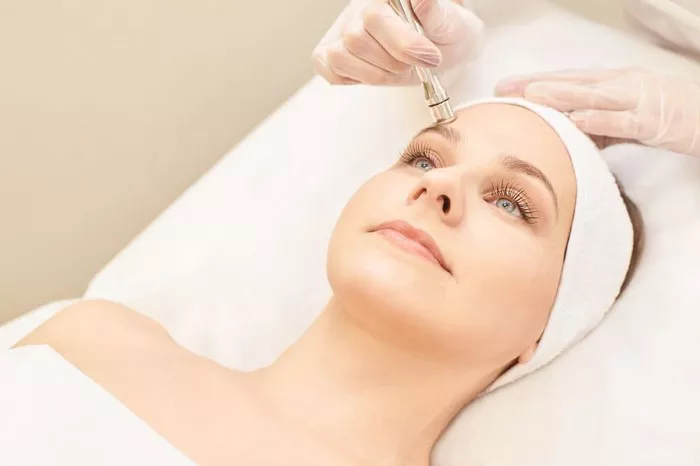Microdermabrasion is a popular skin rejuvenation treatment that involves the use of a special machine to exfoliate the outermost layer of dead skin cells. It’s a non-invasive procedure that can improve the appearance of fine lines, wrinkles, acne scars, hyperpigmentation, and other skin imperfections. But one of the most common questions that people have about microdermabrasion is how long the effects last. In this article, we’ll take a closer look at the longevity of microdermabrasion and what factors can affect its duration.
What is Microdermabrasion?
Before we dive into how long the effects of microdermabrasion last, let’s first understand what microdermabrasion is. Microdermabrasion is a cosmetic procedure that uses a specialized device to remove the outermost layer of dead skin cells. The device has a diamond-tipped wand or a crystal-emitting handpiece that gently abrades the skin’s surface, removing the dead skin cells and stimulating cell turnover.
The procedure is typically performed in a dermatologist’s office or medical spa and takes around 30-60 minutes. After the procedure, patients may experience some redness, swelling, and sensitivity for a few days. However, these side effects are usually mild and resolve quickly.
How Long Do the Effects Last?
Now, let’s get to the question at hand: how long do the effects of microdermabrasion last? The answer depends on several factors, including your skin type, the severity of your skin concerns, and how well you take care of your skin following the procedure.
On average, the effects of microdermabrasion can last anywhere from one to four weeks. However, some patients may see longer-lasting results, especially if they receive multiple treatments over time. In general, patients with less severe skin concerns may see shorter-lived results than those with more significant concerns.
Factors That Affect the Longevity of Microdermabrasion
Several factors can affect how long the effects of microdermabrasion last. These include:
- Skin Type: Patients with oily skin may see shorter-lived results than those with dry or combination skin. This is because oily skin tends to produce more sebum, which can quickly clog pores and cause new skin imperfections.
- Severity of Skin Concerns: Patients with more severe skin concerns, such as deep wrinkles or acne scars, may need multiple treatments to achieve their desired results. In general, the more severe your skin concerns, the more frequent you’ll need to undergo microdermabrasion treatments to maintain the results.
- Sun Exposure: Sun exposure can affect how long the effects of microdermabrasion last. Patients who spend a lot of time in the sun without proper sunscreen protection may see their results fade more quickly. It’s essential to wear sunscreen daily, even on cloudy days, to protect your skin from UV damage.
- Skincare Routine: How well you take care of your skin following microdermabrasion can also affect the longevity of the results. Patients who follow a consistent skincare routine that includes daily cleansing, moisturizing, and sunscreen use may see longer-lasting results than those who don’t.
How Often Should You Get Microdermabrasion?
The frequency of microdermabrasion treatments depends on several factors, including your skin type, the severity of your skin concerns, and how well you take care of your skin between treatments. In general, patients with more severe skin concerns may need more frequent treatments than those with milder concerns.
Most dermatologists and skincare professionals recommend getting microdermabrasion treatments every two to four weeks to maintain optimal results. However, this recommendation may vary depending on individual patient needs.
Benefits of Microdermabrasion
Microdermabrasion has several benefits that make it a popular choice for improving skin texture and appearance. Here are some of the benefits of microdermabrasion:
- Non-Invasive: Microdermabrasion is a non-invasive procedure that doesn’t require anesthesia or downtime.
- Improved Skin Texture: Microdermabrasion can improve the texture of your skin by removing dead skin cells and stimulating cell turnover.
- Reduced Appearance of Wrinkles: Microdermabrasion can reduce the appearance of fine lines and wrinkles, making your skin look younger and smoother.
- Reduced Appearance of Acne Scars: Microdermabrasion can help reduce the appearance of acne scars by stimulating collagen production and promoting skin healing.
- Safe and Effective: Microdermabrasion is a safe and effective procedure that can be used on all skin types.
Conclusion
In conclusion, microdermabrasion is an effective way to improve the appearance of skin imperfections such as fine lines, wrinkles, and acne scars. The longevity of its effects depends on several factors, including your skin type, the severity of your skin concerns, and how well you take care of your skin following the procedure. On average, the effects of microdermabrasion can last anywhere from one to four weeks, but some patients may see longer-lasting results with multiple treatments over time.
To maintain optimal results, it’s essential to follow a consistent skincare routine that includes daily cleansing, moisturizing, and sunscreen use. Patients with more severe skin concerns may need more frequent treatments to achieve their desired results.
Overall, microdermabrasion is a safe and effective way to improve the texture and appearance of your skin. If you’re interested in trying this popular skin rejuvenation treatment, talk to your dermatologist or skincare professional to determine if it’s right for you. With proper care and maintenance, the effects of microdermabrasion can last for weeks, leaving you with smoother, younger-looking skin.

